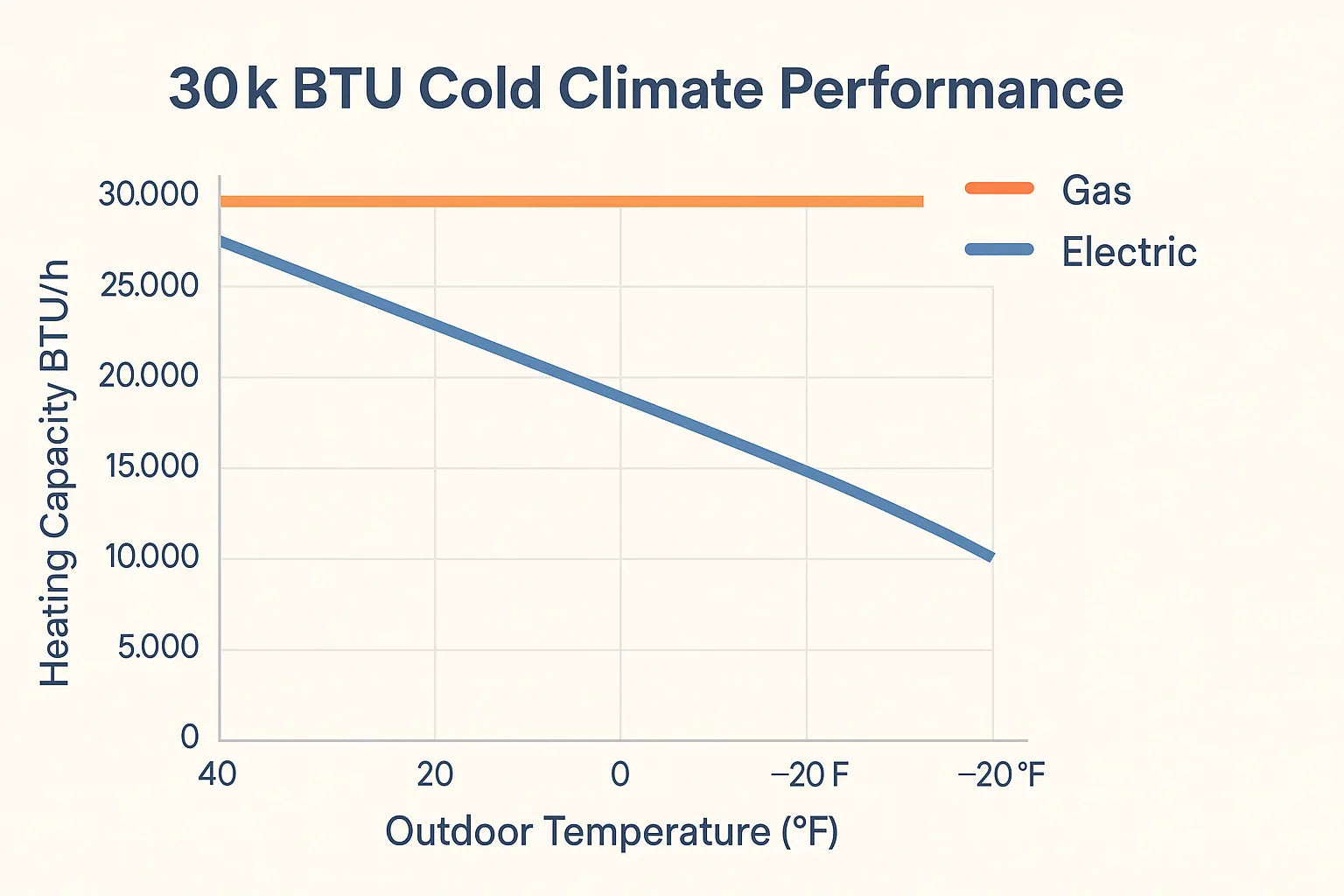❄️ Introduction – The Big Winter Question
I’m Jake, and I’ve had more than one conversation like this:
“Jake, I’m looking at this 30,000 BTU furnace/AC combo, but I live in Minnesota. Will it actually keep my place warm in January?”
The short answer? It depends.
Heating performance in cold climates isn’t just about the BTU number on the label. It’s about how your home holds onto heat, how your ducts deliver it, and whether the system is matched to your winter heating load.
In this guide, we’ll dig into what 30,000 BTUs really means for heating, how that plays out in cold climates, and what you can do to make sure your home stays comfortable even when the snow piles up.
🔥 Section 1 – What 30,000 BTUs Really Means for Heating
A BTU (British Thermal Unit) is the amount of heat needed to raise the temperature of one pound of water by one degree Fahrenheit.
For furnaces:
-
Input BTUs = the heat energy produced by burning fuel or using electricity.
-
Output BTUs = the actual heat delivered to your home after accounting for efficiency losses.
Example:
If you have a gas furnace with 30,000 BTU input and an AFUE rating of 95%, your output is:30,000 × 0.95 = 28,500 BTU of usable heat per hour.
That’s important, because what you feel in your home is the output, not the input.
🏠 Section 2 – Cold Climate Considerations
Heating in cold climates is a bigger challenge because:
-
Heat loss increases the bigger the difference between indoor and outdoor temperatures.
-
Air leaks allow cold air to sneak in (infiltration).
-
Poor insulation lets precious heat escape through walls, ceilings, and floors.
-
Wind chill speeds up heat loss on exposed surfaces.
This means that even a system that works fine in October might struggle in February if your home isn’t tight and well-insulated.
⚖️ Section 3 – Gas Furnace vs. Electric Furnace Performance
Gas Furnace:
-
Delivers steady heat output regardless of outdoor temperature.
-
More efficient in very cold climates (especially with high AFUE models).
-
Works even during cold snaps, as long as fuel supply is steady.
Electric Furnace:
-
Efficiency is consistent, but heat output is limited by electrical capacity.
-
Can be expensive to run in very cold climates due to longer run times.
-
Often used in milder climates or with supplemental heating.
For deep winter zones, I usually recommend a gas furnace pairing for a 30k BTU system unless your home is extremely well insulated and your electric rates are low.
📏 Section 4 – The Role of Sizing (Manual J)
A proper Manual J load calculation tells you exactly how much heating capacity you need for your home based on:
-
Square footage
-
Ceiling height
-
Insulation levels
-
Window type and orientation
-
Local design temperature (coldest expected outdoor temperature)
Example:
-
Well-insulated 1,000 sq ft home in Zone 5: ~25,000 BTU needed.
-
Poorly insulated 1,000 sq ft home in Zone 5: ~35,000+ BTU needed.
Oversizing a furnace can cause short cycling (inefficient operation), while undersizing means it runs constantly and still can’t keep up.
🌬 Section 5 – Ductwork and Airflow in Winter
Even the right-sized furnace can underperform if your ducts:
-
Leak heated air into attics or crawlspaces.
-
Are undersized, choking airflow.
-
Aren’t insulated in unconditioned spaces.
Sealing and insulating ducts can improve winter performance dramatically—sometimes more than upgrading the furnace itself.
🌡 Section 6 – Real-World Temperature Thresholds
A 30k BTU system might be perfect for:
-
Small to medium homes in Zones 4–6 (winter lows around 0–20°F) with good insulation.
-
Larger homes in milder Zones 2–3.
In Zone 7 or colder (winter lows −10°F or below), you may need:
-
A higher BTU furnace.
-
A supplemental heat source (gas fireplace, electric baseboard, or heat pump with cold-climate kit).
♻️ Section 7 – Efficiency Strategies for Cold Climates
-
Upgrade to a high-AFUE furnace – Look for 95%+ AFUE models.
-
Add zoning controls – Focus heat where you spend the most time.
-
Seal & insulate your home – Air sealing and attic insulation can reduce heating load by up to 30%.
-
Use a smart thermostat – Programs lower temps when you’re away, then preheats before you get home.
-
Schedule annual maintenance – Keeps burners, blowers, and safety controls in top shape.
📋 Section 8 – Jake’s Cold Climate Checklist
Before winter hits:
-
✅ Get a Manual J load calculation.
-
✅ Inspect and seal ductwork.
-
✅ Upgrade insulation where needed.
-
✅ Choose gas over electric in most cold zones.
-
✅ Consider a backup heat source.
-
✅ Have your furnace serviced before the first freeze.
✅ Conclusion
A 30,000 BTU furnace/AC combo can absolutely keep you warm in cold climates—if it’s correctly sized, installed, and paired with a well-sealed, insulated home. In harsher winter zones, supplemental or backup heat is often the key to staying comfortable without breaking the bank.
If you’re preparing for a cold climate install, check out the
Furnace & Air Conditioner Systems – 30,000 BTUs collection to see systems that fit the bill.
In the next article we will know more about: Troubleshooting Guide: Common Problems with 30,000 BTU Combo Systems & How Jake Fixes Them







